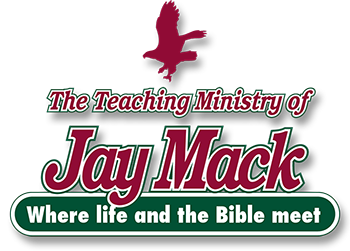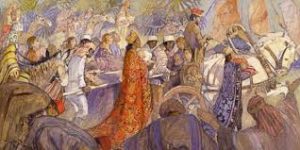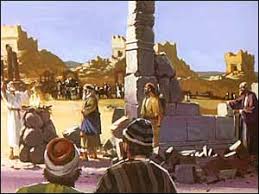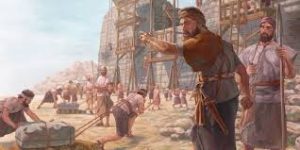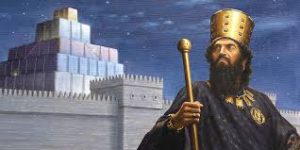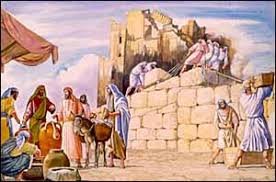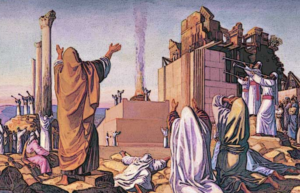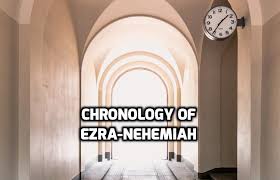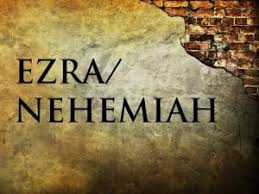An – Priests, Levites and Servants Who Returned with Zerubbabel Ezra 2: 36-60
Priests, Levites and Temple Servants
Who Returned with Zerubbabel
Ezra 2: 36-60
Priests, Levites and Temple servants who returned with Zerubbabel DIG: What is the ratio between the total number of priests and the total membership for the restored community in 2:64? Does the ratio sound top-heavy to you? What long-term needs of the community would be served by that many priests? What other professional groups or classes of people are returning from exile? What do their small numbers say about their relative importance? Moses, Joshua and David gave captives to the Levites for service at the Lord’s altar (Numbers 31:30; Joshua 9:22-27). Yet Ezra and Nehemiah talk of Temple slaves differently, tracing their heirs by name (2:43-54). What change is indicated by their inclusion in this list of returnees?
REFLECT: What is your spiritual gift? Are you using it now? Is it bearing fruit? Is anyone noticing? If not, does that bother you? Why or why not? When have you experienced a time of spiritual restoration: After lapsing in your faith? After moving away from your church or messianic synagogue? After a time of exploring other religions? After an intervention by others? Some other crisis event? Where are you now in your walk with the Lord? Do you talk daily, or do you feel distant now? What can you do about that? Who can you minister to, or, who can you ask for help?
536 BC during the ministry of Zerubbabel (to see link click Ag – The First Return).
Compiled by the Chronicler from the Ezra memoirs
(see Ac – Ezra-Nehemiah from a Jewish Perspective: The Ezra Memoirs).
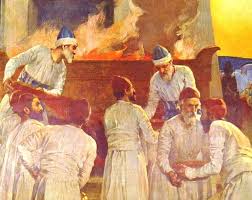
What is the difference between priests and Levites? The Levites were the tribe of Israelites descended from Levi, one of the twelve sons of Jacob. When you think Levites – think Genesis. The priests were a group of qualified men from within the tribe of the Levites who had responsibility over the different aspects of Tabernacle or Temple worship. All priests were to be Levites, according to the Torah, but not all Levites were priests.
When the Jews received the Torah of Moses at Mount Sinai, ADONAI gave commands regarding a formal priesthood for Isra’el (see the commentary on Exodus Fv – The Selection of Aaron and His Sons as Priests). The priests would be males from the tribe of Levi. Among these Levitical priests was the high priest. The first high priest was Aaron, the brother of Moses. His sons and their descendants were to serve as the future priests, and high priests of the nation of Isra’el (see the commentary on Exodus Gf – Dedicate Aaron and His Sons So They May Serve Me As Priests). Only the high priest was permitted to enter the Most Holy Place in the Tabernacle and Temple, and that only once per year on the Day of Atonement (see the commentary on Leviticus Ef – Yom Kippur). So, when you think priests – think Exodus.
The priests needed to meet certain physical and age qualifications in order to serve. In addition, they had to remain ceremonially clean to perform their duties before a holy God. The priests served as mediators between the Israelites and YHVH. They were the ones who performed animal sacrifices on behalf of the people. It was only the priests who were permitted to enter the Holy Place in the Tabernacle and, later, the Temple. Ezra was a Levitical priest (Nehemiah 12:1).34
Basically, the Levites worked under the supervision of the priesthood (Aaron’s sons Eleazar and Ithamar), and that the work of the priests and Levites was different. The priests functioned primarily inside the Sanctuary with the holy things and the Bronze Altar; while the Levites assisted the priests by guarding the outside of the Tabernacle from any encroachment by any Israelite in the camp, carrying the holy things on the march, teaching the people the Torah, being gatekeepers, singers, and also serving as judges in the cities of refuge. ADONAI knew that the priests would need reliable helpers who could assist them in their duties (see the commentary on Numbers Cy – The Duties of the Priests and Levites).
The cohanim, or priests descending from Aaron, returning: There were four clans of priests listed. The first is the sons of Jedaiah, a general name for the clan, or perhaps a special branch of the house of Jeshua the high priest (Zechariah 3:1), 973 (Ezra 3:36). Jeshua was Zerubbabel’s fellow-leader. Their bond was so close that it was seen by Zechariah as the foretaste of the perfect Messianic reign to come, when the priesthood and royalty would be united in a man whose Name is the Branch (Zechariah 6:11-13).35
The three other clans consisted of the sons of Immer, 1,052.
The sons of Pash’chur, the name was borne by one of the priests who put Jeremiah in stocks (see the commentary on Jeremiah Da – Jeremiah and Pash’chur) 1,247.
The sons of Harim, 1,017 (Ezra 2:37-39).
This list provides the names of four clans of priests. They totaled 4,289 in all. This comprised about ten percent of the total mentioned in Ezra 2:64. These are also the only four priestly families listed several generations later when Ezra returned (Ezra 10:18-22). On the one hand, this is surprising since it only represents four of the 24 priestly divisions given to us in First Chronicles 24:17-18. But on the other hand, it is not surprising at all. They gathered together in Tziyon as one man (Ezra 3:1b). They had returned with a single purpose: to rebuild the Temple and restore the worship of ADONAI their God. It is hardly surprising, therefore, that there would be a disproportionate number of priests who wanted to be where the action was. After all, what kind of a priest wouldn’t want to be a part of this historic event!36
By New Covenant times, however, they were again organized into the system of twenty-four divisions with the ancient Davidic names (see the commentary on the Life of David Ev – The Divisions of Priests). The names, especially the mention of Jeshua the high priest, show the continuation of the Jewish community that existed before the exile (see the commentary on Jeremiah Gu – Seventy Years of Imperial Babylonian Rule).
The Levites, those descending from the tribe of Levi, returning: the sons of Jeshua and Kadmiel, through the line of Hodaviah, the general name of the clan of which Jeshua and Kadmiel are separate families (in Ezra 3:9, Judah; in Nehemiah 7:43, Hodevah) 74 (Ezra 2:40). The descendants of Jeshua and Kadmiel were evidently given the responsibility to assist the priests (Ezeki’el 44:10-14). But this was an extremely small number of “priestly helpers” in relation to the priests. Only one Levite for fifty-eight priests. This is quite shocking because Numbers 18:21 and 26 takes for granted a much larger number of Levites than priests. In fact, later Ezra could only get 38 Levites to come back to Tziyon with him (Ezra 8:15-20). This may have been because Levites would have no inheritance to return to since their inheritance was ADONAI (Joshua 13:33, 14:3-4, 18:8, 21:1-42). Although it originally was a curse (Genesis 34:25-31; 49:5-7), Ha’Shem had turned their lack of land possession into a blessing (Exodus 32:25-31; Numbers 18:20; Deuteronomy 33:8-11), but it may have been difficult for many of them to accept that point of view.37
Likewise the singers and gatekeepers would have to wait until their ministries could begin. David founded a special class of Levitical singers of whom there were 24 divisions, corresponding to the 24 priestly divisions. They returned in faith that the Temple would be rebuilt and that their services would be needed. And even then, their tasks would be menial and unseen. Like so much of God’s service, theirs was a thankless task, and their small numbers may reflect the menial labor they volunteered to do. But return they did, seeing the task as more important than any personal gain they might acquire from it.
The singers: the sons of Asaph, 128 (Ezra 2:41). He is given credit for a number of the Psalms. None of the other great guilds of singers, Jeduthun or Heman, seem to have returned.
The sons of the gatekeepers: the sons of Shallum, the name occurs again as that of Maaseiah son of Shallum the doorkeeper (Jeremiah 35:4), the sons of Ater, the sons of Talmon, the sons of Akkub, the sons of Hatita, the sons of Shobai, in all 139 (Ezra 2:42). They were Levites.
If the tasks of the Levites were menial, the tasks of the Temple servants and Solomon’s servants were even more so. These, according to Ezra 8:20, had been given by David to assist the Levites. They were fifth-century interns of the lowest kind. Well over half of them have foreign names, suggesting that their descendants had been taken as prisoners during the monarchy (First Kings 9:20-21). Now, generations later, they were numbered among the people of God! Exodus 12:48a makes it clear that if a Gentile accepted circumcision, the covenant blessings were all theirs (Numbers 15:14ff). So they were no longer slaves, and their return would have been voluntary. Somewhere along the line, they came to believe in the God of Abraham, Isaac, and Jacob through their performance of menial duties around the Temple and had become proselytes of the Covenant (see the commentary on Acts Bb – An Ethiopian Asks about Isaiah 53).38
Temple servants returning: The temple servants (Hebrew: nethinim) were the men who assisted the Levites in performing the humblest jobs connected with the Temple service. Part of them lived in Jerusalem and part were distributed among the Levitical cities. According to Numbers 31:30-47, some war captives were given to serve the Levites. They may be identical with the strangers in the Land of Isra’el whom David gathered for the work of building the Temple (First Chronicles 22:2). Gibeonites were also enslaved and set apart for service by Joshua (Joshua 9:21-27). They were, therefore, called the nethinim, the given [to God], or the devoted. They were held in low esteem by the Jews, occupying a social position even lower than the mamzer, or illegitimate offspring. But because of the Babylonian exile, their organization was broken up, and though some returned to Jerusalem, they were probably not so numerous as before.39
These were the sons of Ziha, the sons of Hasupha, the sons of Tabbaoth, the sons of Keros, the sons of Siaha, the sons of Padon, the sons of Lebanah, the sons of Hagabah, the sons of Akkub, the sons of Hagab, the sons of Shalmai, the sons of Hanan, the sons of Giddel, the sons of Gahar, the sons of Reaiah, the sons of Rezin, the sons of Nekoda, the sons of Gazzam, the sons of Uzza, the sons of Paseah, the sons of Besai, the sons of Asnah, the sons of Meunim, perhaps the same as the Maonites (Judges 1-:12), a Bedouin tribe in the region south of the Dead Sea. King Uzziah subdued them (Second Chronicles 26:7) and some of their descendants may be referred to here. The sons of Nephisim, the sons of Bakbuk, the sons of Hakupha, the sons of Harhur, the sons of Bazluth, the sons of Mehida, the sons of Harsha, the sons of Barkos, the sons of Sisera, the sons of Temah, the sons of Neziah, the sons of Hatipha (Ezra 2:43-54).
The sons of Solomon’s servants: the sons of Sotai, the sons of Hassophereth (meaning the female scribe), the sons of Peruda, the sons of Jaalah, the sons of Darkon, the sons of Giddel, the sons of Shephatiah, the sons of Hattil, the sons of Pochereth-hazzebaim (meaning huntress of the gazelles), the sons of Ami.
This group is closely related to the Temple servants, since both groups are included in one total. All the temple servants and the sons of Solomon’s servants were only 392 from the total of 45 families of clans, or an average of fewer than 9 per clan (Ezra 2:55-58). They are said to be the descendants of the native population hired by the king for work in the Temple (First Kings 9:20ff).
Now these are those who came up from Tel-melah, Tel-harsha (meaning the salt-mound, the forest-mound, probably locations in Babylonia), Cherub, Addan (Addon in Nehemiah 7:61) and Immer, but they were not able to give evidence of their fathers’ households and their descendants, whether they were of Isra’el: the sons of Delaiah, the sons of Tobiah, the sons of Nekoda, 652 (Ezra 2:59-60). They had no access to genealogical records. The importance of family records was for settling claims of property and to ensure that the restored community had an unbroken descent from the original Isra’el. But it was not pressed beyond this point: those who made unsuccessful claims were not sent back, but evidently in principle given the same standing as circumcised foreigners.
Yet for all its value in preserving the chosen people, this emphasis on a pure Isra’el had considerable dangers, as the Brit Chadashah shows by its attacks on those who prided themselves on their pedigree (see the commentary on The Life of Christ Jd – Seven Woes on the Torah-teachers and the Pharisees). Presumably we have our own form of this temptation today, and our own lesson to draw from Paul’s cliché: For not all those who are descended from Isra’el are Isar’el (Romans 9:6).40
These collective facts remind us that ministering through our spiritual gifts need not be glamorous. In fact, our ministry may be such that no one ever takes notice of it – something that can often be the source of some irritation and resentment. But nothing that we do for the Lord is unnoticed. Even a cup of cold water given in Yeshua’s name is recognized and praised (Matthew 10:42). Our motivation should merely be to please Jesus, and when we make it our aim to be pleasing to Him, in everything, however small and insignificant, we will be a sweet smelling aroma. We have an audience of One.
The Second Exodus: Just as in the First Exodus under the leadership of Moses, so here with Zerubbabel, the same notes sound: the people return to the Land, and with the urging of ADONAI, a foreign pharaoh/king urged them to leave. They initially settle in around Jerusalem, just as their forefathers did. Their neighbors provided them with gold and silver vessels to take with them, not even needing to be instructed by Cyrus to do so (Ezra 1:6); just as in Moshe’s time, their numbers include animals and female and male singers (Ezra 2:65-67; Exodus 12:38). And the purpose, then as well as now, was worship (Exodus 3:12).
The rebuilding of the ruined Temple was central to their future. Their identity as the people of God meant nothing unless they could worship in accordance with the way that Moses had laid down and that they had been implemented in Solomon’s Temple. It was for this that they had left their lives in Babylon and returned to the uncertainties of Yerushalayim. They had to put ADONAI first in thought, principle, affection, and action. For all of God’s people, true worship must be placed before any other consideration. Men and women of all ranks of society joined in the cause with initial enthusiasm, knowing that it was for this purpose that Ha’Shem brought them into a relationship with Himself.
YHVH is seeking worshipers – now just as much as then. Yeshua said: But an hour is coming – it is here now – when the true worshipers will worship the Father in spirit and truth, for the Father is seeking such people as His worshipers (John 4:23). He is seeking worshipers who are prepared to put the worship of God before everything else and worshipers who are willing to engage in worship in the way God has set down in His Word.
True worship wars against the world. It had been impossible to worship ADONAI in the biblical pattern in Babylon. For all but the octogenarians, the exiles had never experienced biblical worship. It’s like someone today saying, “We have settled down, bought homes, opened IRA’s, and dug in for the long run. Don’t bother me, I’m comfortable.” The Israelites who stayed in Babylon had the same mindset. In short, they had become like the world around them. Unfortunately, that’s what has happened to far too many believers today.
However, the righteous of the TaNaKh who returned to the City of David were determined to change all of that, and that true biblical worship be restored. At least, that was their intention. To what extent they kept it is another matter, but for now, at least, we should allow the exiles to challenge us in our convictions about the importance of the worship of ADONAI in our lives. How important is it to us that we worship God as He has designed? What sacrifices would we be prepared to make to ensure it happens?41


